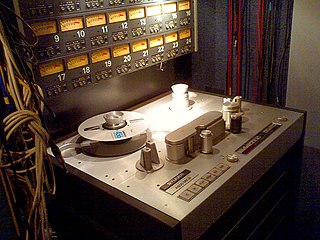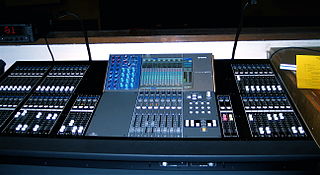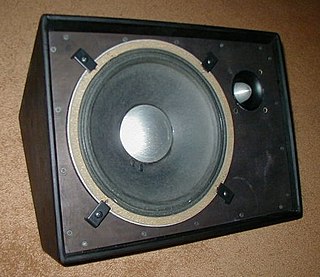
A mixing console or mixing desk is an electronic device for mixing audio signals, used in sound recording and reproduction and sound reinforcement systems. Inputs to the console include microphones, signals from electric or electronic instruments, or recorded sounds. Mixers may control analog or digital signals. The modified signals are summed to produce the combined output signals, which can then be broadcast, amplified through a sound reinforcement system or recorded.

Pro Tools is a digital audio workstation (DAW) developed and released by Avid Technology for Microsoft Windows and macOS. It is used for music creation and production, sound for picture and, more generally, sound recording, editing, and mastering processes.

Adobe Audition is a digital audio workstation developed by Adobe Inc. featuring both a multitrack, non-destructive mix/edit environment and a destructive-approach waveform editing view.

A sound reinforcement system is the combination of microphones, signal processors, amplifiers, and loudspeakers in enclosures all controlled by a mixing console that makes live or pre-recorded sounds louder and may also distribute those sounds to a larger or more distant audience. In many situations, a sound reinforcement system is also used to enhance or alter the sound of the sources on the stage, typically by using electronic effects, such as reverb, as opposed to simply amplifying the sources unaltered.
Solid State Logic (SSL) is a British company based in Begbroke, Oxfordshire, England that designs and markets audio mixing consoles, signal processors, and other audio technologies for the post-production, video production, broadcast, sound reinforcement and music recording industries. SSL employs over 160 people worldwide and has regional offices in Los Angeles, Milan, New York, Paris, and Tokyo, with additional support provided by an international network of distributors. Solid State Logic is part of the Audiotonix Group.
Neve Electronics was a manufacturer of music recording and broadcast mixing consoles and hardware. It was founded in 1961 by Rupert Neve, the man credited with creating the modern mixing console.

Studer is a designer and manufacturer of professional audio equipment for recording studios and broadcasters. The company was founded in Zürich, Switzerland, in 1948 by Willi Studer. It initially became known in the 1950s for its professional tape recorders. In the 1990s the company moved into the manufacture of mixing consoles.

An aux-send is an electronic signal-routing output used on multi-channel sound mixing consoles used in recording and broadcasting settings and on PA system amplifier-mixers used in music concerts. The signal from the auxiliary send is often routed through outboard audio processing effects units and then returned to the mixer using an auxiliary return input jack, thus creating an effects loop. This allows effects to be added to an audio source or channel within the mixing console. Another common use of the aux send mix is to create monitor mixes for the onstage performers' monitor speakers or in-ear monitors. The aux send's monitor mix is usually different from the front of house mix the audience is hearing.
In audio processing and sound reinforcement, an insert is an access point built into the mixing console, allowing the audio engineer to add external line level devices into the signal flow between the microphone preamplifier and the mix bus.

In professional audio, a digital mixing console (DMC) is a type of mixing console used to combine, route, and change the dynamics, equalization and other properties of multiple audio input signals, using digital signal processing rather than analog circuitry. The digital audio samples, which is the internal representation of the analog inputs, are summed to what is known as a master channel to produce a combined output. A professional digital mixing console is a dedicated desk or control surface produced exclusively for the task and is typically more robust in terms of user control, processing power and quality of audio effects. However, a computer can also perform the same function since it can mimic its interface, input and output.
Euphonix was a professional audio company located in Mountain View, California, United States. Euphonix produced the first successful line of large digitally controlled analog audio mixing consoles in the late 1980s and has since moved on to all-digital systems. In 2010, it was acquired by Avid.

The Yamaha M7CL is a digital mixer that was manufactured by Yamaha Pro Audio. Two models with onboard analog input exist: the M7CL-32 and M7CL-48. These models have 40 - and 56 -input channels respectively, counting mono channels. Mixes, masters, groups, DCAs and individual channels can then be routed to an output via any number of the board's 16 configurable output XLR ports. The eight faders of the master control section can control multiple functions by way of "layers" in the same manner as the Yamaha PM5D. The board features Yamaha's "Selected Channel" technology, and Centralogic, unique to the M7CL. It can be augmented with more inputs or outputs via expansion cards, and can be fitted with third-party cards such as ones made by Aviom (A-Net), AuviTran (EtherSound), Audinate, AudioService (MADI), Dan Dugan (automixer), Riedel Communications (RockNet), Waves Audio, and Optocore. The M7CL-48ES recently joined the line-up with built-in EtherSound for digital networking using EtherSound stage boxes.

Live sound mixing is the blending of multiple sound sources by an audio engineer using a mixing console or software. Sounds that are mixed include those from instruments and voices which are picked up by microphones and pre-recorded material, such as songs on CD or a digital audio player. Individual sources are typically equalised to adjust the bass and treble response and routed to effect processors to ultimately be amplified and reproduced via a loudspeaker system. The live sound engineer listens and balances the various audio sources in a way that best suits the needs of the event.
A Virtual Mixer is a software application that runs on a computer or other digital audio system. Providing the same functionality of a digital or analog mixing console, a virtual mixer takes the audio outputs of many separate tracks or live sources and combines them into a pair of stereo outputs or other routed subgroups for auxiliary outputs.
Audio signal flow is the path an audio signal takes from source to output. The concept of audio signal flow is closely related to the concept of audio gain staging; each component in the signal flow can be thought of as a gain stage.

A stage monitor system is a set of performer-facing loudspeakers called monitor speakers, stage monitors, floor monitors, wedges, or foldbacks on stage during live music performances in which a sound reinforcement system is used to amplify a performance for the audience. The monitor system allows musicians to hear themselves and fellow band members clearly.
Graham Blyth is an English audio engineer who is known for designing mixing consoles. He is a co-founder of Soundcraft, a manufacturer which Blyth helped form into a world leader in sound reinforcement and recording mixers, establishing the "British sound". After succeeding in electrical engineering he became a professional organist, performing on pipe organs around the world. Blyth is a Fellow of both the Royal Society of Arts (RSA) and the Audio Engineering Society (AES). In 2012 he was awarded an honorary doctorate degree in science from the University of Hertfordshire.

A matrix mixer is an audio electronics device that routes multiple input audio signals to multiple outputs. It usually employs level controls such as potentiometers to determine how much of each input is going to each output, and it can incorporate simple on/off assignment buttons. The number of individual controls is at least the number of inputs multiplied by the number of outputs.
The X32 Digital Mixing Console is a digital mixing console conceived and designed by German manufacturer Behringer. The console features 40-input channels, 25-bus, 32 XLR microphone input and 16 XLR output busses. The console features 25 100mm motorised faders, a user assignable control panel, Ethernet connectivity and an iPad and iPhone control application.
The Solid State Logic SL 4000 is a series of large-format analogue mixing consoles designed and manufactured by Solid State Logic (SSL) from 1976 to 2002. 4000 Series consoles were widely adopted by major commercial recording studios in the 1980s.











